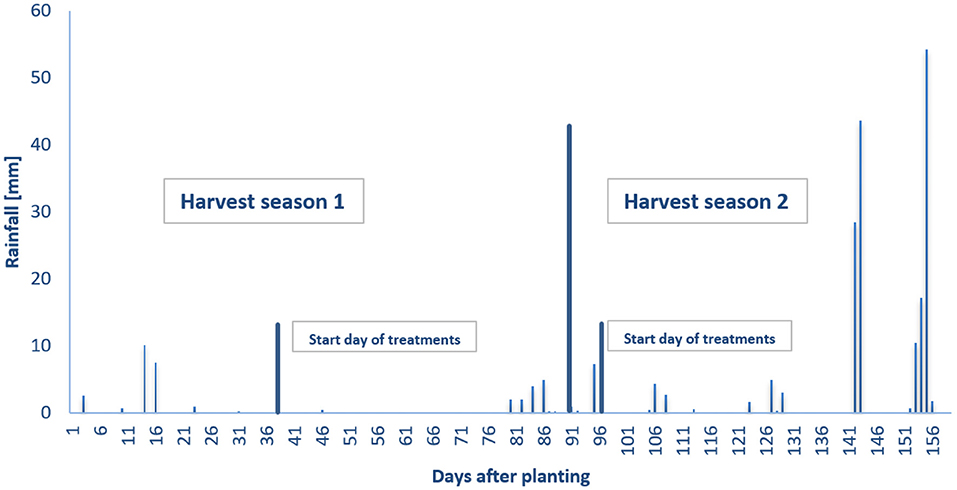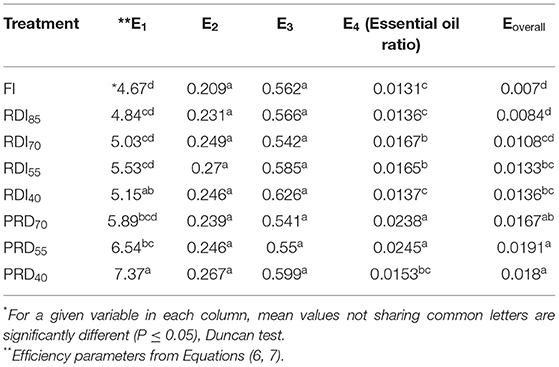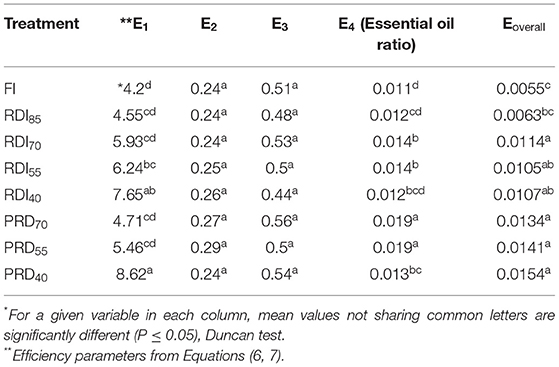- 1Irrigation and Drainage, Sari Agricultural Sciences and Natural Resources University, Sari, Iran
- 2Water Engineering Department, Sari Agricultural Sciences and Natural Resources University, Sari, Iran
The effect of deficit irrigation on water productivity in the water supply and utilization chain has been computed, employing a systematic and quantitative approach. By applying such an investigation, weaknesses and strengths of deficit irrigation strategies could be revealed, and actions and measures could be implemented to improve water productivity as much as possible. The peppermint plants were subjected to regulated deficit irrigation (RDI) and partial root-zone drying (PRD). Peppermint was cultivated under full irrigation (FI, control) and RDI treatments including RDI85, RDI70, RDI55, and RDI40, receiving 85, 70, 55, and 40% of FI treatment, respectively; PRD techniques including PRD70, PRD55, and PRD40, receiving 70, 55, and 40% of FI treatment in one side of the root-zone at each irrigation event, respectively during two cutting seasons. There was no significant improvement in leaves weight and dried yield step by applying deficit irrigation treatments. Leaves and aerial parts from the whole plant and dried yield as the main source of essential oil had the weakest function, which should be optimized to adjust and gain more efficiency. In the essential oil yield step, as a final procedure, the highest improvements were observed in PRD55 treatment with 90% improvement in efficiency compared to control treatment. According to the results and calculating water productivity, PRD55 treatment improved water productivity by 179% compared to the control treatment. Two-way ANOVA analysis, between deficit volume and the deficit applying method, showed that total water productivity was affected (increased) significantly by the deficit applying method. This implies the contribution of the PRD technique to enhance more signals than RDI-based signals, which resulted in more improvements in secondary metabolism production in peppermint.
Introduction
Sustainable agriculture involves setting up an equivalency between ingredients and resources, which are used in crop production systems in a way that, besides reasonable yield, provide sustainable production. Water is the most important fraction of resources, which plays an essential role in the production cycle. Due to the limited availability of fresh water, there are many pressures on the agricultural sector as the largest consumer of water to improve water productivity (WP). Food production using water as a critical input is usually a complicated process that is influenced by management decisions and environmental criteria. To inspect where the inefficiency lies, to evaluate the potential improvements, and most importantly of all, to discover how to allocate available resources to maximize the enhancement in water productivity, a systematic and quantitative approach is needed (Hsiao et al., 2007).
One of the methods to increase WP is irrigation management practices based on understanding the effects of water deficit. Water stress affects plant growth and productivity in many ways. Most of the reactions have a negative impact on production, but plants have different and often multiplex mechanisms to react to water shortages. Regulated deficit irrigation (RDI) and partial root-zone drying (PRD) are strategies of reducing irrigation rates and managing how and where to irrigate during a specific period of growth and development, to conserve water and managing plant growth while maintaining yield and quality. RDI has frequently been proved to be an efficient tool to optimize water-use efficiency (WUE) of different crops such as grapes, pears, citrus, etc. (Cui et al., 2008; Romero et al., 2013; Panigrahi et al., 2014). By alternately wetting and drying part of the root-zone, PRD may allow the induction of abscisic acid (ABA)-based root-to-shoot chemical signaling to regulate growth and water use (Wang et al., 2012). Across several crop species, PRD has shown a potential in saving water and increasing WUE (Iqbal et al., 2020).
Concept of The Chain of Efficiency Steps
As the production procedure is complex and resources at a beginning point proceed consecutively through numerous stages, resulting in the final product, an approach was presented to quantify the total efficiency of the whole production system through each individual efficiency step (Hsiao et al., 2007). In every procedure, because of consecutive steps, the output of each efficiency step would be the input for the next step. Also, the second efficiency output would be the third step input, and so on. In the form of an equation:
The total efficiency is then determined by the following calculation between each efficiency of individual steps from Equation (2).
Deficit irrigation could improve WP by adjusting water application efficiency and harvest index (yield efficiency). Improvements achieved by applying deficit irrigation strategies could be formulated by the equations below:
Various plants have different efficiency in terms of irrigation water used. In a condition of low water availability, gaining water from the land has priority, implementing deficit irrigation strategies to achieve more capital gained per unit of water is of special importance. Medicinal plants, as a collection of plants with high economic value, can produce more capital than other plants in terms of water shortage. Peppermint herb, which is widely used in medicines, hygiene, and oral medications, was selected for this experiment. The peppermint plant is cultivated for mercantile purposes by processing essential oil, dry leaves, and fresh herbs. Toothpaste, mouthwashes, chewing gum, pharmaceuticals, and confectionery and aromatherapy commodities are some of the products in which peppermint essential oil is a main aromatic material (Zheljazkov et al., 2010). It is now obvious that drought and water deficit could change the secondary metabolite production revenue in aromatic and medicinal plants. However, results were not comprehensive in peppermint plants. Nakawuka et al. (2014) investigated the impact of water deficit on quality, yield, and production costs of native peppermint. Their field test consisted of four levels of irrigation: 40, 54, 80, and 100% of ETc. They indicated that applying 40% of full irrigation on native spearmint could produce an essential oil amount of equivalent quality and quantity to that extracted from plants which were fully irrigated. They also reported that water deficit could intensify WP and decline the overall production costs in native spearmint. Hassanpour et al. (2014) reported that, applying 50 percent of field capacity (FC) in Mentha pulegium L., increased essential oil yield by 60%. Kheiry et al. (2017) showed that the essential oil ratio in peppermint was increased significantly by applying water at 75% of field capacity. Also, Farhoudi (2017) reported an increment of 60% in oil yield production in chamomile in mild stress conditions (75% of field capacity). The objective of the current study was to determine the efficiency of each step from fresh herb yield to essential oil of peppermint and WP with regulated deficit irrigation and partial root-zone drying in field conditions. The weakest stages, in terms of efficiency and differences between treatments, would be discovered. Medicinal plants with oil as the final product mostly have complex procedures in generating essential oil and even very little improvement on the process could result in valuable economic return. To the best of our knowledge, the effects of partial root-zone drying on medicinal plants and especially peppermint have not yet been investigated.
Materials and Methods
The field experiments were carried out in 2013 at the research farm of Sari Agricultural Sciences and Natural Resources University, Sari, Iran. Weather data were collected at a nearby climate station (12 km). Figure 1 illustrates precipitation during the growing season. The soil texture was clay loam with a pH of 7.4, containing 0.98% organic carbon, 100 ppm available potassium, and 1.8 ppm available phosphors. Soil moisture (volumetric water content) at field capacity in the plant root-zone was 30% and bulk density was 1.36 g/cm3. The experimental area was divided into 32 plots of 3 × 2 m2 (length × width). Plots of peppermint explants (5 cm pieces of rhizomes) were planted on May 7, 2013. Each plot consisted of five rows with 3 m length, 40 cm between rows, and a distance of 20 cm between plants in the rows.
The experimental design was a randomized complete block with four replications and eight irrigation treatments. Irrigation treatments included full irrigation (FI) that received 100% of evaporation demand; regulated deficit irrigation (RDI) consisted of RDI85, RDI70, RDI55, and RDI40 receiving 85, 70, 55, and 40% of FI treatments at each irrigation event; the partial root-zone drying (PRD) strategy consisted of PRD70, PRD55, and PRD40, respectively receiving 70, 55, and 40% of FI treatments in one side of the root-zone at two irrigation events. Plant water use (evapotranspiration) was estimated by monitoring water balance components in the soil. A soil water balance ingredient consists of surface runoff, drainage, soil water storage, irrigation, and precipitation. Water was applied in 2-day intervals and the rates of irrigation amounts were planned below the infiltration rate to confirm no losses to deep percolation or surface runoff. Drainage was also presumed to be zero. Because based on Equation (5), irrigation amount was calculated regarding the root-zone depth. Also, moisture changes were monitored in 10-cm interval with TDR probes. In almost all the growing seasons, no changes were observed in the 20-cm probe. It means no water drained out from the root-zone. Also, two observation wells around the field were monitored for water table variation and no changes were observed during growing seasons. Indeed, water balance components, which were involved as input, were irrigation and rainfall. Net irrigation requirement (In. mm) was determined based on the following equation:
Where θFc and θBi are volumetric soil water content at field capacity and before irrigation (%), respectively; Di is soil layer depth (mm); i is layer number and n is a number of layers; θFc was measured in the field and laboratory before planting time. θBi was measured by time domain reflectometer sensors (TDR), before each irrigation event. IDRG SMS T-2 TDR probes (DurUntash Lab, USA) were installed in two layers, measuring the soil moisture variations in 10-cm intervals. TDR probes were calibrated by measuring soil volumetric moisture in the laboratory. Volume of water that should have been applied to each treatment was calculated by multiplying its percentage by irrigation amount from Equation (5). Water application efficiency in the irrigation system was assumed to be 80%. A drip irrigation system with two parallel drip lines with emitters of every 20 cm with a flowrate of 4 L per hour for each row in the plot was used to apply the irrigation treatments. The radius of the surface wetted by each dripper was about 12 to 15 cm. Soil moisture was monitored on both sides of the plant with TDR probes to check if the expected water deficit occurred in the root environment in PRD treatments. All plots were irrigated to the same amount to set up uniform stands across all plots. Deficit irrigation treatments were implemented 40 days after planting on June 17, 2013. The volume of irrigation applied to each one of the plots was measured by flow meters.
Plants were harvested in the mid-flowering stage, 92 days after planting after removal of two adjacent rows of plants and 30 cm from each side on August 6, 2013. Plants in cutting season 2 were harvested on October 7, 2013. Plants were weighed for fresh herbage yield, air-dried in the shade for 1 week, and then they were weighed for biological yield. Essential oil contents from flowers and aerial parts were determined using a Clevenger apparatus. Air-dried flowers and leaves were finely ground and 80 g was subjected to 500 ml of water distillation for 3 h using the Clevenger apparatus.
According to the efficiency chain, the first step would be the amount of water used to produce fresh herbage yield. Then we obtained the dried yield. After that, we extracted the essential oil from leaves and aerial parts. Therefore, our chain of efficiencies was as follows:
To calculate improvements (Δ) achieved in each step and for each treatment, the below equation were applied.
In Equation (8), Δ1 is the improvement fraction related to new results after implementing treatments. Based on Equation (4), new total efficiency would be determined by multiplying the old efficiency by the multiplicand of each stage improvement factor (1 +Δi).
One-way analysis of variance (ANOVA) was used to determine treatment effects, with means discriminated by applying Duncan multiple range test (p < 0.05) in SPSS version 21. Furthermore, to distinguish effects of irrigation volume and placement on each step efficiency, two-way ANOVA was used for the RDI70, RDI55, and RDI40 and corresponding PRD treatments: PRD70, PRD55, and PRD40.
Results and Discussion
Yield and yield components and essential oil yield are summarized in Table 1. Irrigation treatments had a significant effect on all yield parameters except leaves and aerial parts. Fresh herbage yield increased with increasing the depth of applied water. Maximum fresh herbage yield corresponded to FI treatment (9,427 kg.ha−1) whereas the lowest one was observed in RDI40 treatment (5,729 kg.ha−1). Significant reduction in fresh herbage yield as a result of water deficit was also reported by Ghanbari and Ariafar (2013) and Esmaeilzade et al. (2019) in peppermint, Okwany et al. (2011) and Meskelu et al. (2014) in spearmint, Khalil et al. (2010) and Ekren et al. (2012) in basil, and Ozturk et al. (2004) in lemon balm. There was no significant difference between FI and RDI85 and PRD70. PRD treatments outperformed RDI treatments in term of fresh herbage yield.

Table 1. Effect of deficit irrigation management on fresh herbage yield, dried yield, leaves and aerial parts weight, and essential oil yield of peppermint in the 1st and 2nd cutting seasons.
Biological yield significantly decreased by implementing deficit irrigation practices. Similar to the results of fresh herbage yield, the highest biological yield was achieved in FI treatment (1,942 kg.ha−1) and the lowest one was observed in RDI40 treatment (1,288 kg.ha−1). There was no significant difference between FI, PRD, and RDI treatments except RDI40 in biological yield. In herbaceous plants, yield components consist of leaves and stems. There was no significant difference in leaves weight, stem, and wooden parts weight between treatments. However, there was a downward trend in both PRD and RDI treatments, which caused a considerable reduction in fresh herbage yield and biological yield. Significant decrease in leaves weight and dried herb yield were reported by Ekren et al. (2012) in purple basil and Esmaeilzade et al. (2019) and Ghanbari and Ariafar (2013) in peppermint.
According to Table 1, the highest oil yield was achieved in PRD70 treatment (23.67 kg/ha) and the lowest one was obtained in RDI40 treatment (11 kg/ha). Despite decreasing irrigation regimes, there was no significant difference between RDI and FI treatments. In RDI treatments, essential oil yield indicated an upward trend to RDI70 treatment and after that, it decreased with applying more water deficit levels. Applying PRD70 and PRD55 significantly increased oil yield. PRD treatments outperformed RDI treatments in terms of oil yield and it was more than full irrigation treatment. The upward trend and significant increase in essential oil ratio in medicinal and aromatic plants affected by water deficit have also been documented by Nakawuka et al. (2014) in spearmint, Ghanbari and Ariafar (2013) and Charles et al. (1990) in peppermint, Ozturk et al. (2004) in lemon balm, Ekren et al. (2012) in purple basil, and Rahmani et al. (2012) in marigold. Ghanbari and Ariafar (2013) reported that maximum oil ratio achieved in 30 percent of field capacity and highest stem weight belonged to 70 percent of field capacity, whereas the highest oil yield was achieved in 50 percent of field capacity in peppermint.
Tables 2–4 demonstrate the results related to the efficiency of each step in the essential oil production process and improvements achieved in each step. Total water to the plants in FI treatment, including irrigation volume and rainfall, for the first growing season was 2,022 m3 and for the second growing season was 1,820 m3. Figure 2 shows the total water depth (irrigation + rainfall) delivered to the plant during the first growing season. In the second growing season, because of heavy rainfalls, just five irrigation events were applied and most of the water was supplied from rainfall.
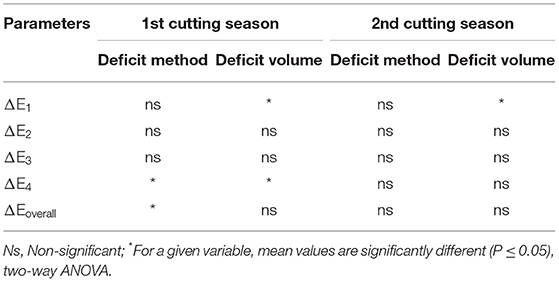
Table 3. Evaluation of the effect of the deficit method and deficit volume on improvement of efficiency in an essential oil production process in cutting seasons 1 and 2 compared to FI.
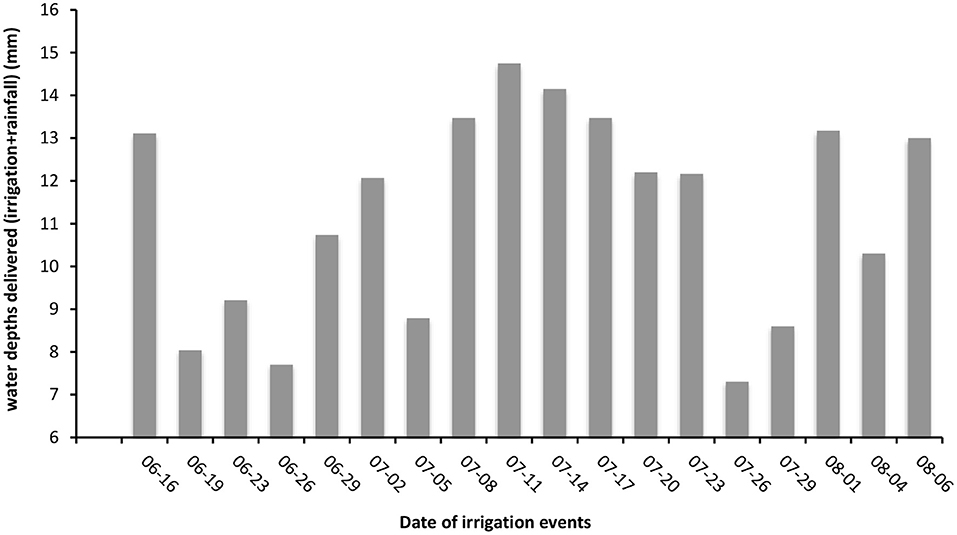
Figure 2. Water depth (irrigation + rainfall) delivered to the plant in each irrigation event in FI treatment during the first growing season.
The highest efficiency in fresh herb yield was achieved in PRD40 which was expected. Highest efficiency without significant difference with the highest yield achieved in PRD70 had as much as a 5.52 and 21.3% improvement compared to FI treatment. The highest efficiency in fresh herb yield conversion to dried yield was achieved in RDI55. Highest efficiency without significant difference with highest dried yield achieved in PRD40 has as much as a 0.26 and 31.1% improvement compared to FI treatment. According to the non-significant difference among leaves and aerial parts' highest efficacy and improvement, both were observed in RDI40 to be as much as 0.63 and 16.1% compared to FI treatment. In the bottommost stage, which was essential oil yield from leaves and aerial parts, the highest improvement in efficiency achieved in PRD55 was about 90.73% compared to FI treatment.
Ghanbari and Ariafar (2013) believed that water deficit would rise the oil percentage of aromatic and medicinal plants. In moisture deficit conditions, secondary metabolites will be produced to prevent oxidization in plant cells. Rahmani et al. (2012) also support this idea that an increase in essential oil ratio is a response to water deficit to reduce the intercellular oxidative damages in the marigold plant. Charles et al. (1990) demonstrated that water deficit might influence essential oil accumulation indirectly by the impact on net assimilation or splitting of plant growth and differentiation processes. Diminution in growth induced by water deficit could result in a new pattern of resource dividing, probably supplying more carbon skeletons for oil accumulation and synthesis. In addition, enzymes production in the Calvin cycle should be synchronized to prevent an over excitation of the electron transport chain leading to structural damage by accumulation of reactive oxygen species (ROS) in drought stress conditions. Selmar and Kleinwächter (2013) stated that the absorption of CO2 will be declined along with closing stomata in the absence of water and it could result in intensification of secondary metabolites production. Therefore, the expenditure of reduction equivalents like NADPH+H+ will be decreased greatly in the Calvin cycle for CO2 stabilization. It will cause an oversupply of NADPH+H+ and push forward the composition of highly reduced ingredients like essential oils. For instance, changes in the essential oil content and composition in Lamiaceae species under water deficit have been reported by different studies like Khorasaninejad et al. (2011) and Nowak et al. (2010).
In the ΔE1 parameter, in both cutting seasons, increasing drought level and applying PRD resulted in more improvement compared to FI treatment (Figures 3, 4). According to Table 3, this improvement was significantly due to drought level with no affect by the deficit applying method. In both cutting seasons, for ΔE2 and ΔE3, there was no cohesive trend in changes, and deficit volume and deficit method had no significant role in observed differences (Figures 3, 4; Table 3). In the first cutting season, raising deficit level and changing the deficit applying method had a significant effect on efficiency improvement in the amount of essential oil extracted from leaves and aerial parts (Figure 3; Table 3). Against that, in cutting season 2, despite of decrement in efficiency improvement, two factors of drought level and deficit applying method had no significant role in this reduction (Figure 4; Table 3).
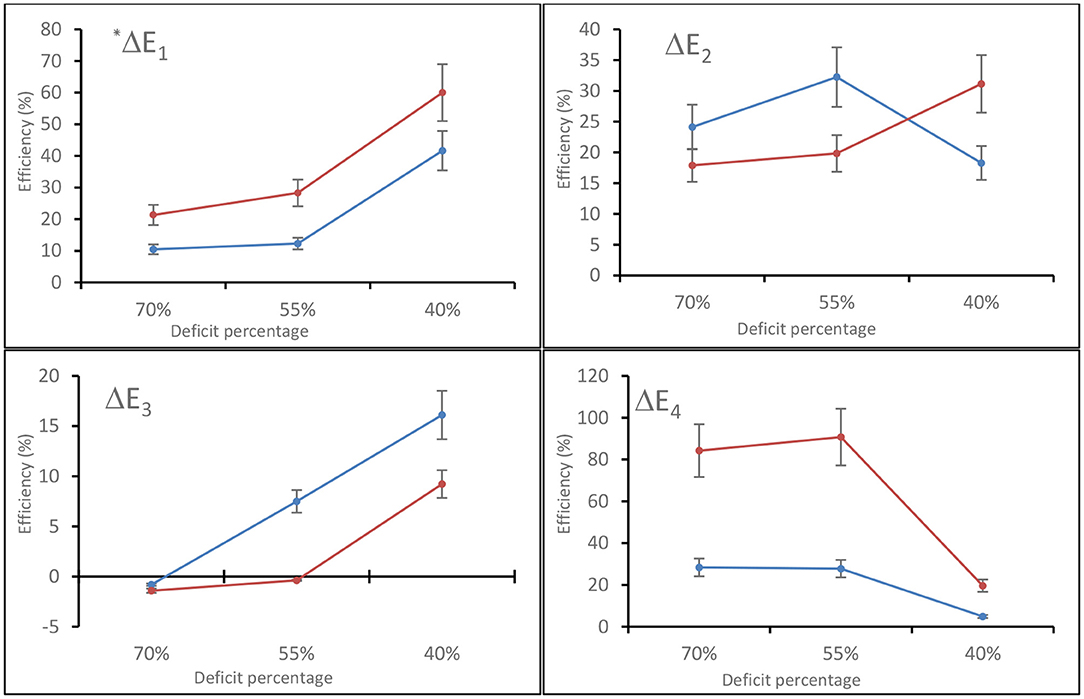
Figure 3. The percentage of an improvement in the efficiency of each step in the 1st cutting season compared to FI. *Δ: Parameter from Equation (8).
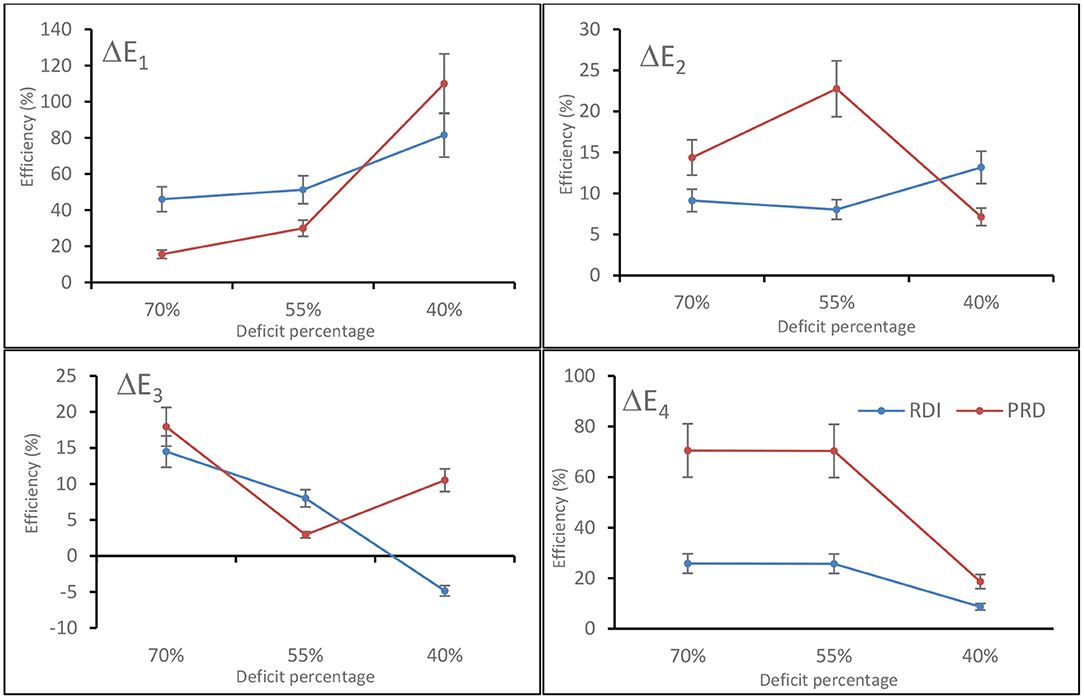
Figure 4. The percentage of an improvement in the efficiency of each step in the 2nd cutting season compared to FI. *Δ: Parameter from Equation (8).
Water productivity improvement was affected (increased) significantly by the deficit applying method. Increasing drought level had no significant effect in changes of improvement, which were observed in water productivity of the essential oil production process. This implies the contribution of the PRD technique to enhance more signals than RDI-based signals, which resulted in more improvements in the secondary metabolism product in peppermint (Figure 5A; Table 3). In the second cutting season, despite increasing improvement in water productivity, no significant affect was caused by drought level or deficit applying method (Figure 4; Table 3).
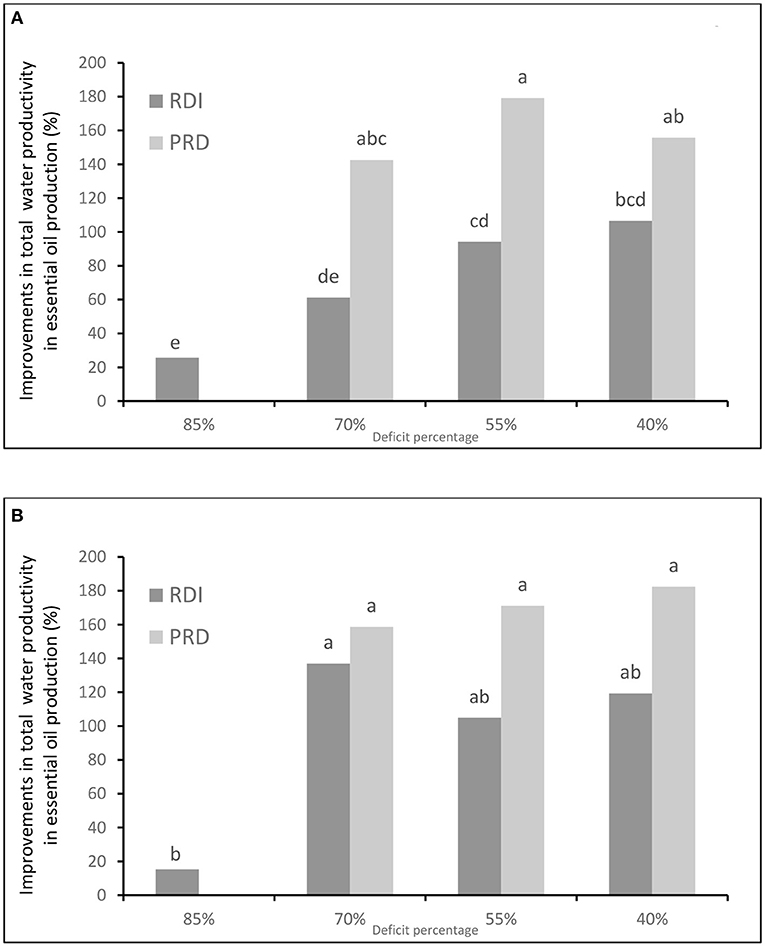
Figure 5. Percentage of improvements in total WP of essential oil production (A) in the first cutting season and (B) in the second cutting season. For a given variable in the chart bars, mean values not sharing common letters are significantly different (P ≤ 0.05), Duncan test.
According to Figure 5A, with WP of essential oil production as the main phase, PRD55 treatment had the highest improvement of as much as 179% compared to FI treatment which had no significant difference with PRD70 treatment in oil yield. In second season, the highest improvement in essential oil production observed in PRD40 treatment, though there was no significant difference between RDI and PRD treatments (Figure 5B). Both regulated deficit irrigation and partial root-zone drying enhanced water productivity of the oil production stage. According to Table 2, the stage with the lowest efficiency in essential oil production was leaves and aerial parts from dried yield. Regarding Equation (3) and the chain feature of efficiencies, farm management strategies should be applied to improve efficiency of this step. Results in recent studies on WP of the essential oil production process show that WPs observed in FI and RDI treatments in this study were in the same range with other findings. Sharma and Kanjilal (1999) showed that changing plant density would cause increasing leaves to stem ratio. In addition, Alsafar and Al-Hassan (2009) and Poshtdar et al. (2016) demonstrated that optimizing fertilizer use rate has a positive effect on peppermint leaves yield. Applying these management approaches alongside deficit irrigation practices will induce the efficiency of this step which, because of the multiplication property of efficiencies, has a great influence on the WP of essential oil production.
Conclusion
High values of total efficiencies of oil production in Table 2 and Figure 2 in PRD treatments compared to FI and RDI treatments show the high performance of this deficit irrigation strategy. Applying the PRD technique, along with an investigation into the efficiency obtained in each stage, demonstrated that this technique, in addition to quality enchantments effects, could also be applied for efficiency betterment. With studying WP of the essential oil production in peppermint with chain features included, the phase with the lowest efficiency could be recognized so that it could be adjusted with a specific management plan. In this study, leaves and aerial parts production as main source of essential oil had the weakest function, which should be optimized to adjust and gain more efficiency. This implies the importance of other management strategies beside deficit irrigation practice for gaining optimum yield from the unit of water delivered to the field.
Data Availability Statement
The original contributions presented in the study are included in the article/supplementary material, further inquiries can be directed to the corresponding author.
Author's Note
This is the original article, which its abstract, presented at the Third World Irrigation Forum in Bali, Indonesia, 2019.
Author Contributions
Both authors listed have made a substantial, direct and intellectual contribution to the work, and approved it for publication.
Funding
This work was supported by Sari Agriculture Science and Natural Resources University.
Conflict of Interest
The authors declare that the research was conducted in the absence of any commercial or financial relationships that could be construed as a potential conflict of interest.
Publisher's Note
All claims expressed in this article are solely those of the authors and do not necessarily represent those of their affiliated organizations, or those of the publisher, the editors and the reviewers. Any product that may be evaluated in this article, or claim that may be made by its manufacturer, is not guaranteed or endorsed by the publisher.
References
Alsafar, M. S., and Al-Hassan, Y. M. (2009). Effect of nitrogen and phosphorus fertilizers on growth and oil yield of indigenous mint (Mentha longifolia L.). Biotechnology 8, 380–384. doi: 10.3923/biotech.2009.380.384
Charles, D. J., Joly, R. J., and Simon, J. E. (1990). Effects of osmotic stress on the essential oil content and composition of peppermint. Phytochemistry 29, 2837–2840. doi: 10.1016/0031-9422(90)87087-B
Cui, N., Du, T., Kang, S. H., Li, F., Zhang, J., Wang, M., et al. (2008). Regulated deficit irrigation improved fruit quality and water use efficiency of pear-jujube trees. Agric. Water Manag. 95, 489–497. doi: 10.1016/j.agwat.2007.11.007
Ekren, S., Sönmez, C., Özcakal, E., Kukul Kurttas, Y. S., Bayram, E., and Gürgülü, H. (2012). The effect of different irrigation water levels on yield and quality characteristics of purple basil (Ocimum basilicum L.). Agric. Water Manag. 109, 155–161. doi: 10.1016/j.agwat.2012.03.004
Esmaeilzade, N. S., Sadeghi, A., and Moradi, P. (2019). Streptomyces strains alleviate water stress and increase peppermint (Mentha piperita) yield and essential oils. Plant Soil 434, 441–452. doi: 10.1007/s11104-018-3862-8
Farhoudi, R. (2017). Evaluation of drought stress effect on growth, essential oil percentage and essential oil yield of chamomile (Matricaria recutita L. Presov cultivar) and Chicory (Cichorium intybus L. local cultivar) in the North of Khuzestan. J. Horticult. Sci. 31, 122–130. doi: 10.22067/jhorts4.v0i0.46691
Ghanbari, M., and Ariafar, S. (2013). The effects of water deficit and zeolite application on growth traits and oil yield of medicinal peppermint (Mentha piperita L.). Int. J. Med. Aromat. Plants 3, 32–39. Available online at: https://www.researchgate.net/publication/273369438_The_Effects_of_Water_Deficit_and_Zeolite_Application_on_Growth_Traits_and_Oil_Yield_of_Medicinal_Peppermint_Mentha_piperita_L
Hassanpour, H., Khavari-Nejad, R. A., Niknam, V., Razavi, K. H., and Najafi, F. (2014). Effect of penconazole and drought stress on the essential oil composition and gene expression of Mentha pulegium L. (Lamiaceae) at flowering stage. Acta Physiol. Plant. 36, 1167–1175. doi: 10.1007/s11738-014-1492-1
Hsiao, T. C., Steduto, P., and Fereres, E. (2007). A systematic and quantitative approach to improve water use efficiency in agriculture. Irrig. Sci. 25, 209–231. doi: 10.1007/s00271-007-0063-2
Iqbal, R., Raza, M. A. S., Toleikiene, M., Ayaz, M., https://www.researchgate.net/profile/Fatemeh-Hashemi-4 F., Habib ur Rahman, M., et al. (2020). Partial root-zone drying (PRD), its effects and agricultural significance: a review. Bull. Natl. Res. Centre 44, 1–15. doi: 10.1186/s42269-020-00413-w
Khalil, S. E., Abd El-Aziz, N. G., and Abou Leila, B. H. (2010). Effect of water stress, ascorbic acid and spraying on some morphological and biochemical composition of Ocimum basilicum plant. J. Am. Sci. 6, 33–44. http://dx.doi.org/ doi: 10.3923/jbs.2006.763.767
Kheiry, A., Tori, H., and Mortazavi, N. (2017). Effects of drought stress and jasmonic acid elicitors on morphological and phytochemical characteristics of peppermint (Mentha piperita L.). Iran. J. Med. Aromat. Plants Res. 33, 268–280. doi: 10.22092/ijmapr.2017.106481.1783
Khorasaninejad, S., Mousavi, A., Soltanloo, H., Hemmati, K., and Khalighi, A. (2011). The effect of drought stress on growth parameters, essential oil yield and constituent of peppermint (Mentha piperita L.). J. Med. Plant Res. 5, 5360–5365. Available online at: https://academicjournals.org/journal/JMPR/article-abstract/10E1A0C16443
Meskelu, E., Mohammed, M., Yimenu, F., and Derese, Y. (2014). Spearmint (Mentha spicata L.) response to deficit irrigation. Int. J. Recent Res. Life Sci. 1, 22–30. Available online at: https://www.researchgate.net/publication/321426637_Spearmint_Mentha_spicata_L_Response_to_Deficit_Irrigation
Nakawuka, P., Peters, T. R., Gallardo, K. R., Toro-Gonzalez, D., Okwany, R. O., and Walsh, D. B. (2014). Effect of deficit irrigation on yield, quality, and costs of the production of native spearmint. J. Irrig. Drain. Eng. 140, 1–9. doi: 10.1061/(ASCE)IR.1943-4774.0000719
Nowak, M., Kleinwachter, M., Manderscheid, R., Weigel, H. J., and Selmar, D. (2010). Drought stress increases the accumulation of monoterpenes in sage (Salvia officinalis), an effect that is compensated by elevated carbon dioxide concentration. J. Appl. Bot. Food Qual. 83, 133–136. Available online at: https://ojs.openagrar.de/index.php/JABFQ/article/view/2138
Okwany, R. O., Peters, T. R., Ringer, K. L., Walsh, D. B., and Rubio, M. (2011). Impact of sustained deficit irrigation on spearmint (Mentha spicata L.) biomass production, oil yield, and oil quality. Irrig. Sci. 30, 213–219. doi: 10.1007/s00271-011-0282-4
Ozturk, A., Unlukara, A., Ipek, A., and Gurbuz, B. (2004). Effects of salt stress and water deficit on plant growth and essential oil content of lemon balm (Melissa officinalis L.). Pak. J. Bot. 36, 787–792. Available online at: https://www.researchgate.net/publication/268341096_Effects_of_salt_stress_and_water_deficit_on_plant_growth_and_essential_oil_content_of_lemon_balm_Melissa_officinalis_L
Panigrahi, P., Sharma, R. K., Hasan, M., and Parihar, S. (2014). Deficit irrigation scheduling and yield prediction of ‘Kinnow' mandarin (Citrus reticulate Blanco) in a semiarid region. Agric. Water Manag. 140, 48–60. doi: 10.1016/j.agwat.2014.03.018
Poshtdar, A., Abdali Mashhadi, A. R., Moradi, F., Siadat, S. A., and Bakhshandeh, A. (2016). Ecological and phytochemical response of Mentha piperita L. to nitrogenous fertilizers types in Khuzestan region. Eco Phytochem. J. Med. Plants 4, 19–32. Available online at: https://www.sid.ir/en/Journal/ViewPaper.aspx?ID=504778
Rahmani, N., Taherkhani, T., Zandi, P., and Moradiaghdam, A. (2012). Effect of regulated deficit irrigation and nitrogen levels on flavonoid content and extract performance of marigold (Calendula officinalis L.). Ann. Biol. Res. 3, 2624–2630. Available online at: https://www.researchgate.net/publication/228325596_Effect_of_regulated_deficit_irrigation_and_nitrogen_levels_on_flavonoid_content_and_extract_performance_of_marigold_Calendula_officinalis_L
Romero, P., Gil-Munoz, R., del Amor, F. M., Valdes, E., Fernandez, J. I., and Martinez-cutillas, A. (2013). Regulated deficit irrigation based upon optimum water status improves phenolic composition in monastrell grapes and wines. Agric. Water Manag. 121, 85–101. doi: 10.1016/j.agwat.2013.01.007
Selmar, D., and Kleinwächter, M. (2013). Stress enhances the synthesis of secondary plant products: the impact of stress-related over-reduction on the accumulation of natural products. Plant Cell Physiol. 54, 817–826 doi: 10.1093/pcp/pct054
Sharma, P. C., and Kanjilal, P. B. (1999). Effect of planting time and density on yield and quality of peppermint (Mentha piperita L.) under sub-tropical condition. Anc. Sci. Life 18, 284–289.
Wang, Z., Liu, F., Kang, S. H., and Jensen, C. H. R. (2012). Alternate partial root-zone drying irrigation improves nitrogen nutrition in maize (Zea mays L.) leaves. Environ. Exp. Bot. 75, 36–40. doi: 10.1016/j.envexpbot.2011.08.015
Keywords: drought, food security, irrigation management, partial root-zone drying, water productivity
Citation: Akbarzadeh A and Shahnazari A (2021) The Effect of Deficit Irrigation Strategies on the Efficiency From Plant to Essential Oil Production in Peppermint (Mentha piperita L.). Front. Water 3:682640. doi: 10.3389/frwa.2021.682640
Received: 18 March 2021; Accepted: 07 June 2021;
Published: 06 August 2021.
Edited by:
Paul Celicourt, Laval University, CanadaReviewed by:
Alireza Pirzad, Urmia University, IranMarcelo Santos, Instituto Federal de Educação, Ciência e Tecnologia Baiano (IFBAIANO), Brazil
Copyright © 2021 Akbarzadeh and Shahnazari. This is an open-access article distributed under the terms of the Creative Commons Attribution License (CC BY). The use, distribution or reproduction in other forums is permitted, provided the original author(s) and the copyright owner(s) are credited and that the original publication in this journal is cited, in accordance with accepted academic practice. No use, distribution or reproduction is permitted which does not comply with these terms.
*Correspondence: Ali Shahnazari, YWxpcG9uaEB5YWhvby5jb20=
 Ali Akbarzadeh
Ali Akbarzadeh Ali Shahnazari
Ali Shahnazari